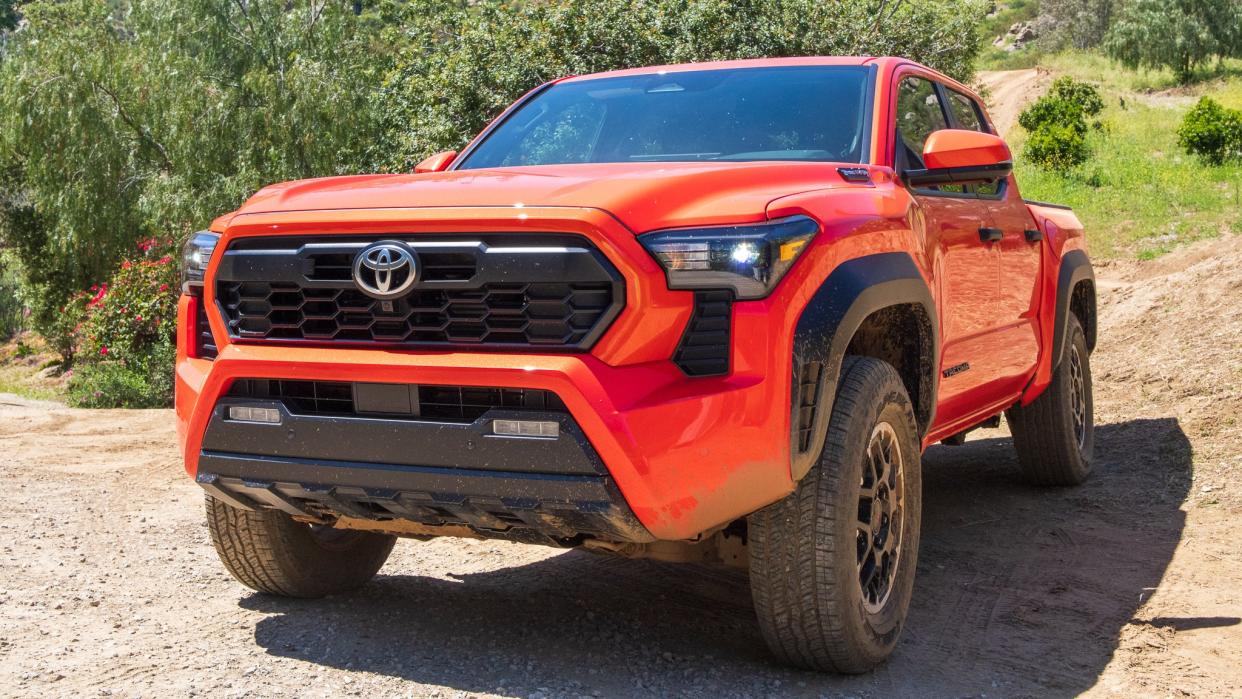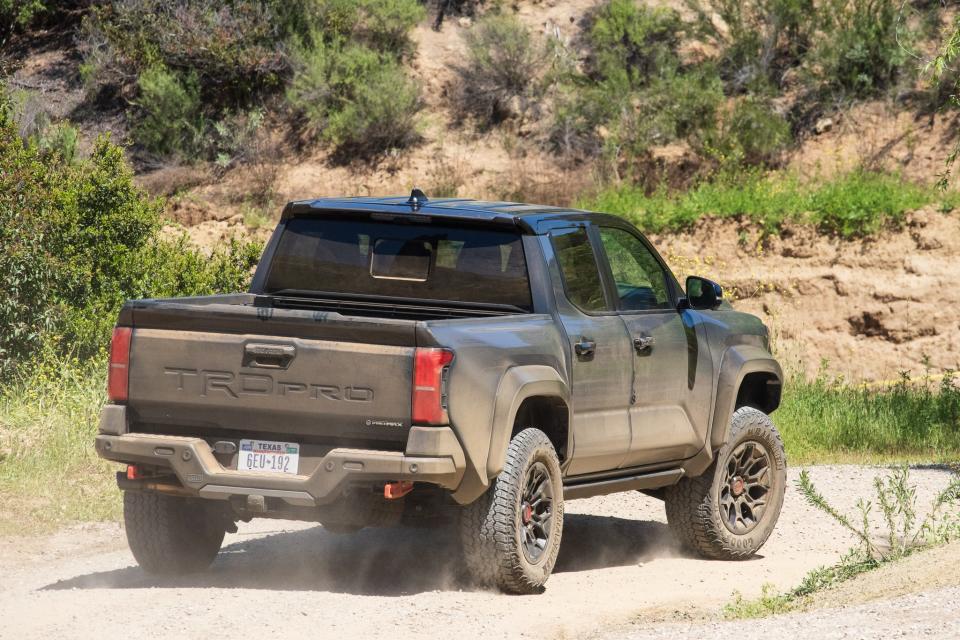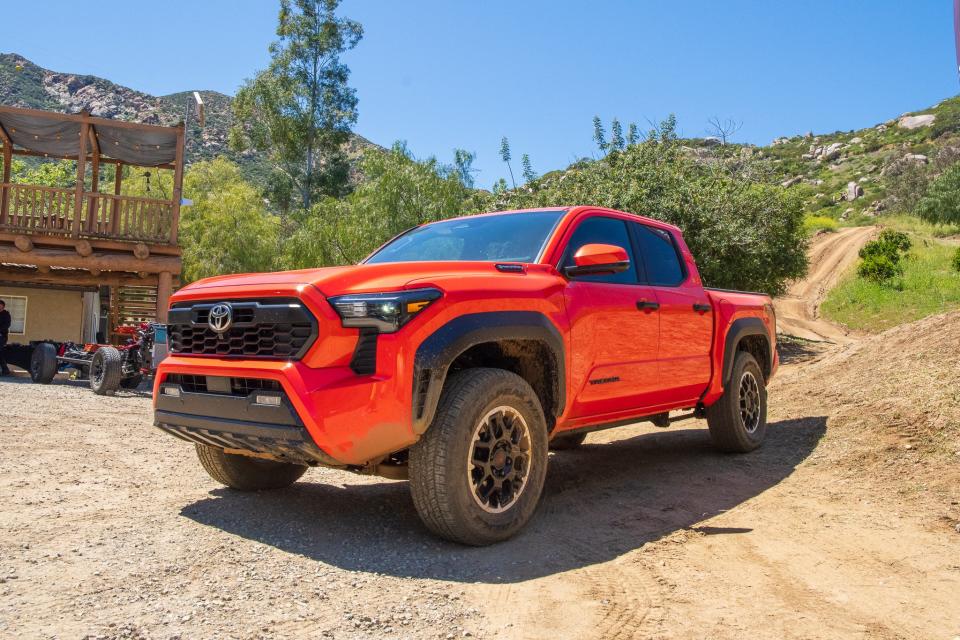2024 Toyota Tacoma Hybrid First Drive Review: Leaping Out of the ICE Age

Like all of Toyota’s popular models, the Tacoma has been slow to evolve. The 2024 Toyota Tacoma, however, represents the midsize truck’s most significant evolution to date because it adds a hybrid option to the lineup and replaces the truck’s long-standing V6 engine. Fans of the Tacoma may be wary of the change, and only time will tell if the electrified powertrain holds up, but first impressions are strong. Hybrid power has done the truck good.
Every new Tacoma features a turbocharged 2.4-liter four-cylinder, albeit in various states of tune and with different hardware attached. The marquee drivetrain for this model is the new hybrid configuration, which combines the truck’s turbo four with an electric motor and raises total output by nearly 100 horsepower—going from 228 hp in a base model truck to 326 hp in upper trim models. And the hybrid setup is also torquey, going up from 243 lb-ft in the gas-only base model to 465 in upper-range Tacomas.
These are performance figures the outgoing V6 can’t even dream of, and together with a slew of upgrades Toyota has given the popular midsizer—from its design to its cabin and suspension—it’s clear that the Tacoma has reached a new peak. The truck is more efficient, more powerful, and absolutely shreds off-road thanks to the hybrid setup. Who could have known the humble Prius could teach the Tacoma a thing or two?



Of course, the Tacoma’s newfangled drivetrain has led to better performance both on the road and off it. But what would it all mean without new looks both inside and out? Toyota has redesigned the Tacoma to better match its looks with those of the Tundra, which is also available as a hybrid now, albeit with a bigger turbo-twin V6 to the Taco’s turbo four. Still, there’s a strong family resemblance between the trucks, especially from the rear with the Tacoma borrowing the Tundra’s tail lights and stamping throughout the sheet metal.
Speaking of the rear end, I will note the standard five-foot bed looks funny combined with the reworked design of the double cab, which is the sole configuration available for buyers who want a hybrid. The proportions just look a little off, and the bed ends up looking truncated as you follow the lines of the truck toward the rear. There is an option for a six-foot bed, but it’s only available on the Trailhunter, the new overlanding flavor for the Taco.
All of Toyota’s new trucks share a design language but the midsizer is still recognizable as a Tacoma—just one that’s been catapulted into the 2020s, leaving behind the looks of the previous model while retaining enough of its DNA to appeal to its fanbase. The Tacoma now has a taller, broader front end that makes it look aggressive, especially once you start getting into any of the TRD trims, of which there are three.





These start with the road-focused Tacoma TRD Sport, then move on to the TRD Off-Road and, of course, the TRD Pro, which is the flagship model. Same as before. The hybrid lineup also includes the Tacoma Limited and Trailhunter models.
The design changes have impacted the truck’s driveability, at least for me. I now have to adjust the driver’s seat by raising it further in order to comfortably see over the bulges in the hood. Luckily, these high-end models boast a highly customizable seating position, and dialing it in is easy with the eight-way adjustable chairs. I’m admittedly shorter than average, so your mileage may vary. So much for midsize trucks being for us little guys!
Many modern midsize pickups have adopted a similar sculpted hood, such as the Chevy Canyon and GMC Colorado, which are vying for the Tacoma’s crown among off-road midsizers, so I understand where Toyota is coming from. But I’m not sure I’m a fan of aggressive front ends; they look cool from the outside, but my brain never manages to filter out the brawny hoods from my line of sight as I’m driving.








But the rest of the view from inside the cabin is light years ahead of previous models. The Tacoma’s interior has historically lagged behind rivals but for the first time, possibly ever, I will concede that the cabin is a nice place to sit while soaking up the miles. Buttons and controls are grouped in intuitive ways, with the dial for changing drive modes and various off-road functions close at hand. The gear selector is prominent but ergonomics are good so it doesn’t feel comically oversized. Major functions are manipulated via rotary controllers that are easy to grip and twist, and the HVAC row sports rockers that you can figure out how to control in seconds.
I want to call out the volume knob specifically because a big burly dial is where it’s at. Despite the 14-inch behemoth of an infotainment screen, the volume knob is hard to miss and it’s very satisfying to crank when the right song comes on as you bomb down the highway.
That’s the other thing that took me by surprise in the hybrid Tacoma: the midsizer is no longer a chore to drive on the highway, and the TRD Sport is about the best model Taco for long-distance. The 48-hp electric motor built into the eight-speed transmission really brings the truck alive while netting decent fuel economy at 24 mpg combined.
The previous Tacoma’s V6 made just 278 hp while this hybrid makes a combined 326 horses. On the highway, the engine cruises comfortably without any strain. More importantly, torque got a massive increase of 75 percent over the V6 engine, so it no longer feels like the Tacoma takes forever to get up to speed in the first place.
When you combine the hybrid powertrain of TRD Sport with its sport-tuned shocks and improved cabin, you get a Tacoma that is no longer a slog on road trips. The Limited model adds more refinement to the interior, which is lined in leather-like Softex; it also differs from all the other hybrids with adaptive variable suspension and full-time four-wheel drive, while the rest get part-time 4WD and a two-speed transfer case. All the hybrids have a max towing capacity of 6,000 pounds, which is 500 pounds less than non-hybrid Tacomas. Also, payload capacity for the hybrids is capped at 1,709 pounds.













As good as the Tacoma TRD Sport and Limited are on the highway, the other trims are equally adept in their environments and are arguably more in line with what the Tacoma has traditionally been all about: off-road prowess. The hybrid configuration has greater torque but, more importantly, it shifted down the power band’s sweet spot. Max torque comes on at 1,700 rpm, which is way below the old V6’s max coming on at 4,600 rpm. That makes the power of the engine more usable and readily available on the trail. Indeed, the TRD Pro scoffs at steep hills and remote paths full of obstacles.
No, you won’t be able to get a hybrid TRD Pro with a manual transmission, or any of the hybrids for that matter. That might be a bummer, but the Tacoma makes up for it with its smart eight-speed automatic, which holds onto gears longer during elevation changes without the need to downshift. The TRD Off-Road and TRD Pro also get a standard e-locking rear diff but the stabilizer bar disconnect is only standard on TRD Pro, while being available on lesser grades.
You can tackle bumpy trails at speed if you want to thanks to the IsoDynamic Performance seats in the TRD Pro, which use shock absorbers to reduce movement and stabilize the driver while driving on rugged terrain. I would call them game-changers but for their fatal flaw, which is that they make the back seat of the Tacoma nearly unusable. Recall that I’m not a tall person. According to my driver’s license, I’m legally 5’3”. I have a 28-inch inseam, and I still couldn’t sit comfortably behind the IsoDynamic seats. It’ll take quite a bit of adjustment for the front driver and passenger as well as rear passengers to easily fit in Tacomas that feature the shock-absorber seats. I guess if you regularly drive with only a passenger in the front, it’s no big deal. But it’s something to keep in mind.







The seats, along with the TRD Pro’s double-wishbone IFS and Fox internal bypass shocks with remote reservoirs, help the Tacoma shrug off trails at speed. It’s no F-150 Raptor-killer but the gap is getting smaller and smaller. Perhaps Ford has seen fit to make the Ranger Raptor available in the U.S. because the lighter Tacoma is on the heels of the big F-150 in terms of rowdy fun while off-roading at higher speeds. Toyota even arranged a strip where we could gun the throttle (aiming for about 45 mph on a narrow dirt road carved into a canyon) and get the Tacoma airborne, even if just a little.
As fun as that jump course was, the Tacoma is so composed and does its job so well that it felt too controlled to rattle drivers with any off-road experience. Then again, I might have scrubbed too much speed and maybe the hybrid’s brakes are just too good, boasting bigger discs front and rear. The ventilated brake discs on hybrid models come in at 13.4 inches at the front and 13.2 at the rear. Compare that with the non-hybrid models, which get 12.6-inch discs up front and 12.2-inch discs rear. At least all Tacomas get four-wheel disc brakes now.









The point is the TRD Off-Road and Pro can handle many off-road tasks with ease, whether it’s high- or low-speed or in between. The new Tacoma Trailhunter, on the other hand, is mainly optimized for low-speed off-roading, which is more the kind of thing you’ll get up to while overlanding. The point is to go far, not fast. The Traihunter’s suspension features Old Man Emu forged monotube shocks tuned for greater control and load-carrying capacity rather than for fast-paced off-roading. There is also a list of upgrades that the Trailhunter gets, including stamped steel skid plates, but one of the main differences is Trailhunter will get an optional six-foot bed unlike all other hybrid models. Both TRD Pro and Trailhunter sport 18-inch alloy wheels wrapped in 33-inch Goodyear Territory rugged terrain tires.
Model bloat often leads to price creep and the Tacoma is no exception. The hybrid truck starts at $47,795 (destination included) for the TRD Sport and will start out at an eye-watering $65,395 for TRD Pro. The Trailhunter will cost a little less at $64,395 with a five-foot bed, or $64,895 with a six-foot bed. Still, that’s a lot of money. The Tacoma TRD Pro competes with the likes of the Ranger Raptor and Colorado ZR2, both of which are a fair deal cheaper in the mid- to high-$50,000s depending on the options buyers go with. That makes the Tacoma TRD Pro among the most expensive midsizers, right up there with the GMC Canyon AT4X.
All this is to say, the 2024 Tacoma is a culmination of 27 years of Toyota’s hybrid development, which pairs the massive popularity of the Tacoma and the remarkable success of the Prius. In that sense, I mentioned at the beginning that this new model is a new peak for Tacoma. It would be more fitting to say this is more like peak Toyota Tacoma—but with an emphasis on make, not model.
That’s because this is a Tacoma born of Toyota’s stubbornness to change. I can’t stress enough that adding a hybrid engine to the truck is as notable as it was inevitable. Who knows when we’ll see an EV Tacoma, if ever; for now, the best Toyota will do is a hybrid. Luckily for Tacoma fans who are skeptical, Toyota knows how to make a great hybrid. And that uniquely Toyota set, or category, finally includes the Tacoma.
2024 Toyota Tacoma i-Force Max Specs | |
|---|---|




